Giuseppe Pellizza da Volpedo
Giuseppe Pellizza da Volpedo (28 July 1868 – 14 June 1907) was an Italian divisionist painter. He was born and died in Volpedo, in the Piedmont region of northern Italy.
Giuseppe Pellizza da Volpedo | |
|---|---|
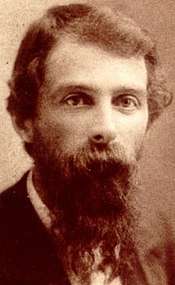 | |
| Born | July 28, 1868 |
| Died | June 14, 1907 (aged 38) Volpedo |
| Education | Academy of Brera, Academy of Fine Arts of Florence |
| Known for | Painting |
Notable work | |
| Style | Neo-impressionism |
| Movement | Divisionism, Symbolism, Realism |
| Spouse(s) | Teresa Bidone |
Pellizza was a pupil of Pio Sanquirico. He used a divisionist technique in which a painting is created by juxtaposing small dots of paint according to specific color theory.
Biography
Paintings
The Fourth Estate

His most famous work, The Fourth Estate ("Il Quarto Stato") (1901), has become a well-known symbol for progressive and socialist causes in Italy, and throughout Europe. The painting is shown during the opening credits of Bernardo Bertolucci's film 1900 and is currently housed at the Museo del Novecento in Milan.[3] An earlier version is held in the Pinacoteca di Brera.
Pellizza hanged himself in 1907, after the deaths of his wife and son.[4]
Gallery
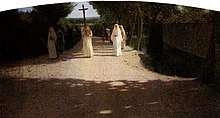 La Processione (The Procession), 1894-1895
La Processione (The Procession), 1894-1895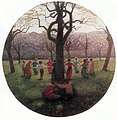 Idillio primaverile (Spring Idyll), 1896-1901
Idillio primaverile (Spring Idyll), 1896-1901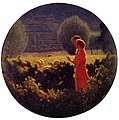 Passeggiata amorosa (Amorous walk), 1901-1902
Passeggiata amorosa (Amorous walk), 1901-1902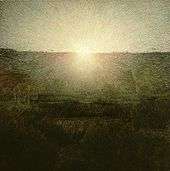 Il Sole (The Sun), 1904
Il Sole (The Sun), 1904
References
- "Capolavori dei Musei di Torino - Lo specchio della vita di Giuseppe Pellizza da Volpedo". ArTo Blog (in Italian). Retrieved 3 July 2018.
- "Idillio primaverile". Pellizza da Volpedo (in Italian). Retrieved 3 July 2018.
- "Il Quarto Stato - In Collezione". Museo del Novecento (in Italian). Retrieved 3 July 2018.
- About Art History - Artists Who Committed Suicide
| Wikimedia Commons has media related to Giuseppe Pellizza da Volpedo. |